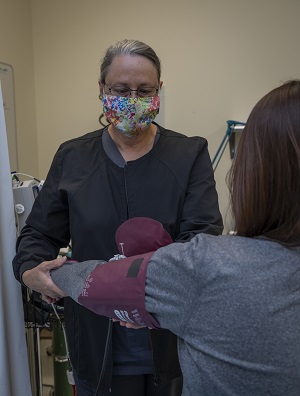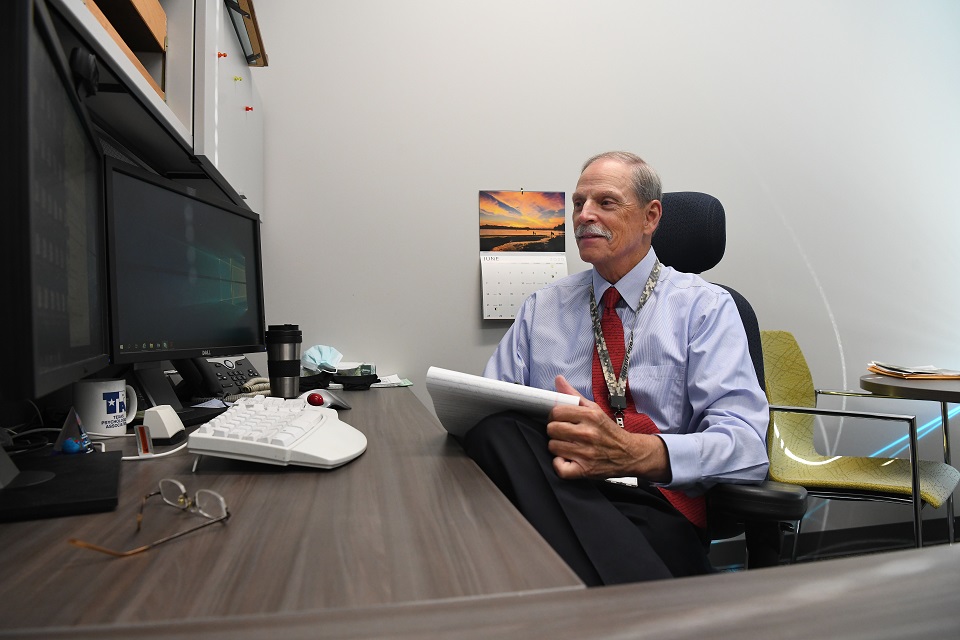 Y-12 nurse Denise Howard checks an employee’s blood pressure. |
The Pantex and Y-12 Occupational Health Services departments have always had a mission to maintain and improve the safety, health, and wellness of employees in the workplace, and their work is more important now than ever before. In the midst of the COVID-19 pandemic, they’ve proven themselves responsive, adaptable, and innovative. OHS is rising to the challenges of meeting ongoing occupational health needs with reduced staffing levels, finding ways to improve for the future, and even blazing new trails.
“I don’t think anyone in Y-12 OHS will ever forget that Monday in March when we learned we had our first case,” said Gary Hall, Y-12 OHS senior manager. “I looked around the room, and I think every single person there felt the tsunami of change coming fast our way. In hindsight, I think it was our exceptional people skills that got us through — we needed to quickly problem solve and then execute. We talked our way through the anxiety our coworkers were feeling.”
To practice proper social distancing, the Pantex and Y-12 groups alternated medical and administrative staff on site with weekly shifts. Even with reduced on site staffing levels, personnel were still able to provide fitness for duty and case management functions.
Procedures that didn’t allow for social distancing, such as audio and pulmonary function tests and physical therapy, have been paused to protect the providers and patients. For other procedures, the groups looked for new ways of meeting requirements.
Pantex and Y-12 OHS started telepsychology, or virtual psychology exams. With the employee in one room and the psychologist in another room, they connect via Skype. The simple solution was a first in the Nuclear Security Enterprise. OHS hopes to soon allow psychologists to offer this service while teleworking from home to further reduce the amount of clinical staff on-site.
Pantex has also changed procedures for alcohol testing. To reduce use of breathalyzer tests and protect Fire Department personnel administering the test, employees called in to work off-shifts now receive saliva testing as a pre-screening and breath alcohol tests only following a positive saliva test.
In addition to providing ongoing health support to the plants, both OHS departments played a major role in the sites’ response to the COVID-19 pandemic. Site Operational Medical Directors Dr. Michael Paston and Dr. Warren Sayre helped develop policies and procedures to protect on site employees and prepare for when the workforce returns during the three stages of the recovery plan.
“We are functioning like our own public health department. The case management staff, led by nurse Melva Davis, is perfecting contact tracing, and we are coordinating with the Amarillo Public Health Department,” said Paston.
Don Morris, Pantex OHS senior manager, said the situation has also encouraged the team to identify opportunities for improvement in other internal processes.
“In some ways, I don’t think we will ever go back to the way we used to do business,” Morris said.
The continuous improvement demonstrated by OHS has not only helped reduce the spread of COVID-19 at both sites but also will further improve the quality of service provided in the future.

Dr. Mark Izzard conducts a telepsychology session from his office at Pantex.